Surface Shaders with DX11 / OpenGL Core Tessellation
In the Built-in Render Pipeline, Surface ShadersA streamlined way of writing shaders for the Built-in Render Pipeline. More info
See in Glossary have some support for DirectX 11 / OpenGL Core GPU Tessellation.
Render pipeline compatibility
| Feature name | Built-in Render Pipeline | Universal Render Pipeline (URP) | High Definition Render Pipeline (HDRP) | Custom SRP |
|---|---|---|---|---|
| Surface Shaders | Yes | No For a streamlined way of creating Shader objects in URP, see Shader Graph. |
No For a streamlined way of creating Shader objects in HDRP, see Shader Graph. |
No |
Overview
- Tessellation is indicated by
tessellate:FunctionNamemodifier. That function computes triangle edge and inside tessellation factors. - When tessellation is used, “vertex modifier” (
vertex:FunctionName) is invoked after tessellation, for each generated vertex in the domain shaderA program that runs on the GPU. More info
See in Glossary. Here you’d typically to displacement mapping. - Surface shaders can optionally compute phong tessellation to smooth model surface even without any displacement mapping.
Current limitations of tessellation support:
- Only triangle domain - no quadsA primitive object that resembles a plane but its edges are only one unit long, it uses only 4 vertices, and the surface is oriented in the XY plane of the local coordinate space. More info
See in Glossary, no isoline tessellation. - When you use tessellation, the shader is automatically compiled into the Shader Model 4.6 target, which prevents support for running on older graphics targets.
No GPU tessellation, displacement in the vertex modifier
This next example shows a surface shader that does some displacement mapping without using tessellation. It just moves vertices along their normals based on the amount coming from a displacement map:
Shader "Tessellation Sample" {
Properties {
_MainTex ("Base (RGB)", 2D) = "white" {}
_DispTex ("Disp Texture", 2D) = "gray" {}
_NormalMap ("Normalmap", 2D) = "bump" {}
_Displacement ("Displacement", Range(0, 1.0)) = 0.3
_Color ("Color", color) = (1,1,1,0)
_SpecColor ("Spec color", color) = (0.5,0.5,0.5,0.5)
}
SubShader {
Tags { "RenderType"="Opaque" }
LOD 300
CGPROGRAM
#pragma surface surf BlinnPhong addshadow fullforwardshadows vertex:disp nolightmap
#pragma target 4.6
struct appdata {
float4 vertex : POSITION;
float4 tangent : TANGENT;
float3 normal : NORMAL;
float2 texcoord : TEXCOORD0;
};
sampler2D _DispTex;
float _Displacement;
void disp (inout appdata v)
{
float d = tex2Dlod(_DispTex, float4(v.texcoord.xy,0,0)).r * _Displacement;
v.vertex.xyz += v.normal * d;
}
struct Input {
float2 uv_MainTex;
};
sampler2D _MainTex;
sampler2D _NormalMap;
fixed4 _Color;
void surf (Input IN, inout SurfaceOutput o) {
half4 c = tex2D (_MainTex, IN.uv_MainTex) * _Color;
o.Albedo = c.rgb;
o.Specular = 0.2;
o.Gloss = 1.0;
o.Normal = UnpackNormal(tex2D(_NormalMap, IN.uv_MainTex));
}
ENDCG
}
FallBack "Diffuse"
}
The above shader is fairly standard:
- Vertex modifier
dispsamples the displacement map and moves vertices along their normals. - It uses custom “vertex data input” structure (
appdata) instead of defaultappdata_full. This is not needed yet, but it’s more efficient for tessellation to use as small structure as possible. - Since our vertex data does not have 2nd UV coordinate, we add
nolightmapdirective to exclude lightmapsA pre-rendered texture that contains the effects of light sources on static objects in the scene. Lightmaps are overlaid on top of scene geometry to create the effect of lighting. More info
See in Glossary.
The image below displays some simple GameObjectsThe fundamental object in Unity scenes, which can represent characters, props, scenery, cameras, waypoints, and more. A GameObject’s functionality is defined by the Components attached to it. More info
See in Glossary with this shader applied.
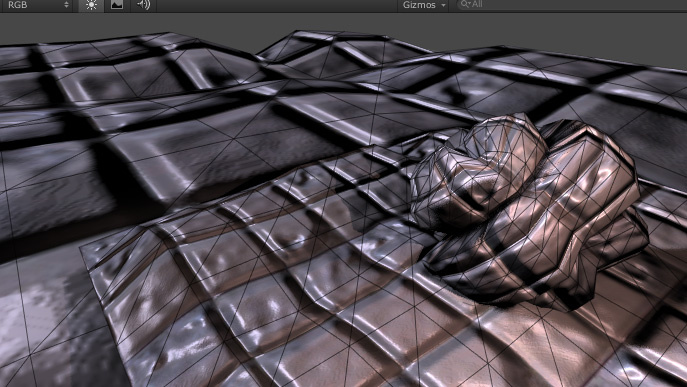
Fixed amount of tessellation
If your model’s faces are roughly the same size on screen, add a fixed amount of tesselation to the MeshThe main graphics primitive of Unity. Meshes make up a large part of your 3D worlds. Unity supports triangulated or Quadrangulated polygon meshes. Nurbs, Nurms, Subdiv surfaces must be converted to polygons. More info
See in Glossary (the same tessellation level over the whole Mesh).
The following example script applies a fixed amount of tessellation.
Shader "Tessellation Sample" {
Properties {
_Tess ("Tessellation", Range(1,32)) = 4
_MainTex ("Base (RGB)", 2D) = "white" {}
_DispTex ("Disp Texture", 2D) = "gray" {}
_NormalMap ("Normalmap", 2D) = "bump" {}
_Displacement ("Displacement", Range(0, 1.0)) = 0.3
_Color ("Color", color) = (1,1,1,0)
_SpecColor ("Spec color", color) = (0.5,0.5,0.5,0.5)
}
SubShader {
Tags { "RenderType"="Opaque" }
LOD 300
CGPROGRAM
#pragma surface surf BlinnPhong addshadow fullforwardshadows vertex:disp tessellate:tessFixed nolightmap
#pragma target 4.6
struct appdata {
float4 vertex : POSITION;
float4 tangent : TANGENT;
float3 normal : NORMAL;
float2 texcoord : TEXCOORD0;
};
float _Tess;
float4 tessFixed()
{
return _Tess;
}
sampler2D _DispTex;
float _Displacement;
void disp (inout appdata v)
{
float d = tex2Dlod(_DispTex, float4(v.texcoord.xy,0,0)).r * _Displacement;
v.vertex.xyz += v.normal * d;
}
struct Input {
float2 uv_MainTex;
};
sampler2D _MainTex;
sampler2D _NormalMap;
fixed4 _Color;
void surf (Input IN, inout SurfaceOutput o) {
half4 c = tex2D (_MainTex, IN.uv_MainTex) * _Color;
o.Albedo = c.rgb;
o.Specular = 0.2;
o.Gloss = 1.0;
o.Normal = UnpackNormal(tex2D(_NormalMap, IN.uv_MainTex));
}
ENDCG
}
FallBack "Diffuse"
}
In the example above, the tessFixed tessellation function returns four tessellation factors as a single float4 value: three factors for each edge of the triangle, and one factor for the inside of the triangle.
The example returns a constant value that is set in the Material properties.
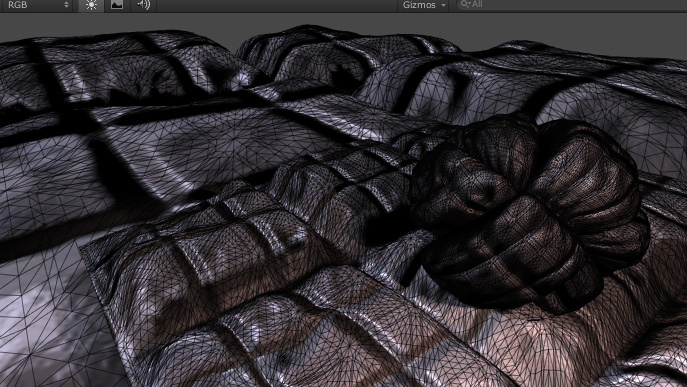
Distance-based tessellation
You can also change tessellation level based on distance from the cameraA component which creates an image of a particular viewpoint in your scene. The output is either drawn to the screen or captured as a texture. More info
See in Glossary.
For example, you could define two distance values:
- The distance when tessellation is at maximum (for example, 10 meters).
- The distance when the tessellation level gradually decreases (for example, 20 meters).
Shader "Tessellation Sample" {
Properties {
_Tess ("Tessellation", Range(1,32)) = 4
_MainTex ("Base (RGB)", 2D) = "white" {}
_DispTex ("Disp Texture", 2D) = "gray" {}
_NormalMap ("Normalmap", 2D) = "bump" {}
_Displacement ("Displacement", Range(0, 1.0)) = 0.3
_Color ("Color", color) = (1,1,1,0)
_SpecColor ("Spec color", color) = (0.5,0.5,0.5,0.5)
}
SubShader {
Tags { "RenderType"="Opaque" }
LOD 300
CGPROGRAM
#pragma surface surf BlinnPhong addshadow fullforwardshadows vertex:disp tessellate:tessDistance nolightmap
#pragma target 4.6
#include "Tessellation.cginc"
struct appdata {
float4 vertex : POSITION;
float4 tangent : TANGENT;
float3 normal : NORMAL;
float2 texcoord : TEXCOORD0;
};
float _Tess;
float4 tessDistance (appdata v0, appdata v1, appdata v2) {
float minDist = 10.0;
float maxDist = 25.0;
return UnityDistanceBasedTess(v0.vertex, v1.vertex, v2.vertex, minDist, maxDist, _Tess);
}
sampler2D _DispTex;
float _Displacement;
void disp (inout appdata v)
{
float d = tex2Dlod(_DispTex, float4(v.texcoord.xy,0,0)).r * _Displacement;
v.vertex.xyz += v.normal * d;
}
struct Input {
float2 uv_MainTex;
};
sampler2D _MainTex;
sampler2D _NormalMap;
fixed4 _Color;
void surf (Input IN, inout SurfaceOutput o) {
half4 c = tex2D (_MainTex, IN.uv_MainTex) * _Color;
o.Albedo = c.rgb;
o.Specular = 0.2;
o.Gloss = 1.0;
o.Normal = UnpackNormal(tex2D(_NormalMap, IN.uv_MainTex));
}
ENDCG
}
FallBack "Diffuse"
}
Here, the tessellation function takes the vertex data of the three triangle corners before tessellation as its three parameters.
Unity needs this to compute tessellation levels, which depend on vertex positions.
The example includes a built-in helper file, Tessellation.cginc, and calls the UnityDistanceBasedTess function from the file to do all the work. This function computes the distance of each vertex to the camera and derives the final tessellation factors.
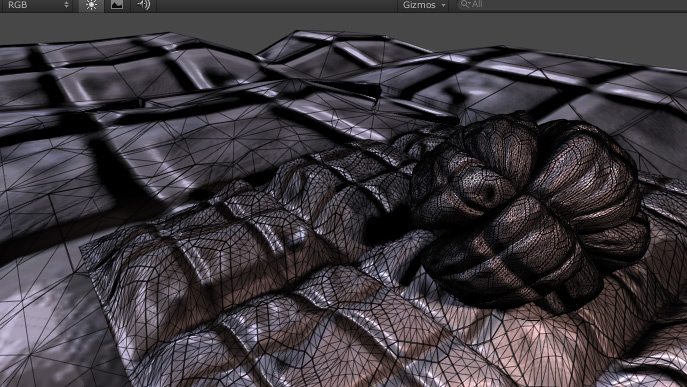
Edge length based tessellation
Purely distance based tessellation is effective only when triangle sizes are quite similar. In the image above, the GameObjects that have small triangles are tessellated too much, while GameObjects that have large triangles aren’t tessellated enough.
One way to improve this is to compute tessellation levels based on triangle edge length on the screen. Unity should apply a larger tessellation factor to longer edges.
Shader "Tessellation Sample" {
Properties {
_EdgeLength ("Edge length", Range(2,50)) = 15
_MainTex ("Base (RGB)", 2D) = "white" {}
_DispTex ("Disp Texture", 2D) = "gray" {}
_NormalMap ("Normalmap", 2D) = "bump" {}
_Displacement ("Displacement", Range(0, 1.0)) = 0.3
_Color ("Color", color) = (1,1,1,0)
_SpecColor ("Spec color", color) = (0.5,0.5,0.5,0.5)
}
SubShader {
Tags { "RenderType"="Opaque" }
LOD 300
CGPROGRAM
#pragma surface surf BlinnPhong addshadow fullforwardshadows vertex:disp tessellate:tessEdge nolightmap
#pragma target 4.6
#include "Tessellation.cginc"
struct appdata {
float4 vertex : POSITION;
float4 tangent : TANGENT;
float3 normal : NORMAL;
float2 texcoord : TEXCOORD0;
};
float _EdgeLength;
float4 tessEdge (appdata v0, appdata v1, appdata v2)
{
return UnityEdgeLengthBasedTess (v0.vertex, v1.vertex, v2.vertex, _EdgeLength);
}
sampler2D _DispTex;
float _Displacement;
void disp (inout appdata v)
{
float d = tex2Dlod(_DispTex, float4(v.texcoord.xy,0,0)).r * _Displacement;
v.vertex.xyz += v.normal * d;
}
struct Input {
float2 uv_MainTex;
};
sampler2D _MainTex;
sampler2D _NormalMap;
fixed4 _Color;
void surf (Input IN, inout SurfaceOutput o) {
half4 c = tex2D (_MainTex, IN.uv_MainTex) * _Color;
o.Albedo = c.rgb;
o.Specular = 0.2;
o.Gloss = 1.0;
o.Normal = UnpackNormal(tex2D(_NormalMap, IN.uv_MainTex));
}
ENDCG
}
FallBack "Diffuse"
}
In this example, you call the UnityEdgeLengthBasedTess function from Tessellation.cginc to do all the work.
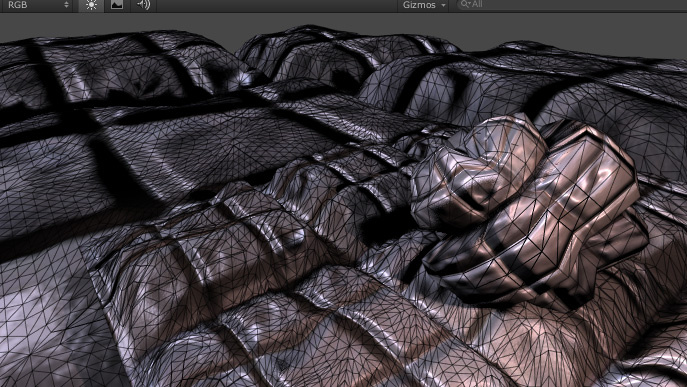
For performance reasons, call the UnityEdgeLengthBasedTessCull function instead, which performs patch frustum culling. This makes the shader a bit more expensive, but saves a lot of GPU work for parts of meshes that are outside of the Camera’s view.
Phong Tessellation
Phong Tessellation modifies positions of the subdivided faces so that the resulting surface follows the mesh normals a bit. It’s quite an effective way of making low-poly meshes become more smooth.
Unity’s surface shaders can compute Phong tessellation automatically using tessphong:VariableName compilation directive. Here’s an example shader:
Shader "Phong Tessellation" {
Properties {
_EdgeLength ("Edge length", Range(2,50)) = 5
_Phong ("Phong Strengh", Range(0,1)) = 0.5
_MainTex ("Base (RGB)", 2D) = "white" {}
_Color ("Color", color) = (1,1,1,0)
}
SubShader {
Tags { "RenderType"="Opaque" }
LOD 300
CGPROGRAM
#pragma surface surf Lambert vertex:dispNone tessellate:tessEdge tessphong:_Phong nolightmap
#include "Tessellation.cginc"
struct appdata {
float4 vertex : POSITION;
float3 normal : NORMAL;
float2 texcoord : TEXCOORD0;
};
void dispNone (inout appdata v) { }
float _Phong;
float _EdgeLength;
float4 tessEdge (appdata v0, appdata v1, appdata v2)
{
return UnityEdgeLengthBasedTess (v0.vertex, v1.vertex, v2.vertex, _EdgeLength);
}
struct Input {
float2 uv_MainTex;
};
fixed4 _Color;
sampler2D _MainTex;
void surf (Input IN, inout SurfaceOutput o) {
half4 c = tex2D (_MainTex, IN.uv_MainTex) * _Color;
o.Albedo = c.rgb;
o.Alpha = c.a;
}
ENDCG
}
FallBack "Diffuse"
}
Here is a comparison between a regular shader (top row) and one that uses Phong tessellation (bottom row). See that even without any displacement mapping, the surface becomes more round.
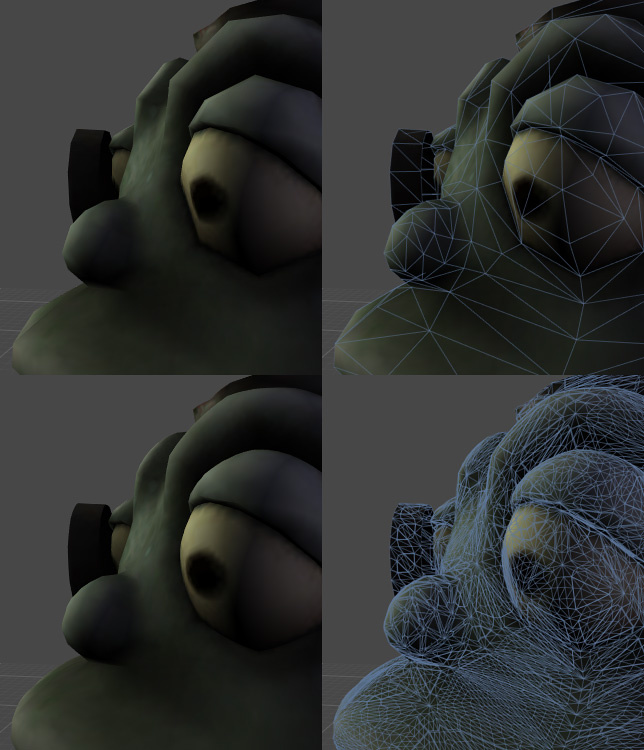
- 2018–03–20 Page amended
- Tessellation for Metal added in 2018.1